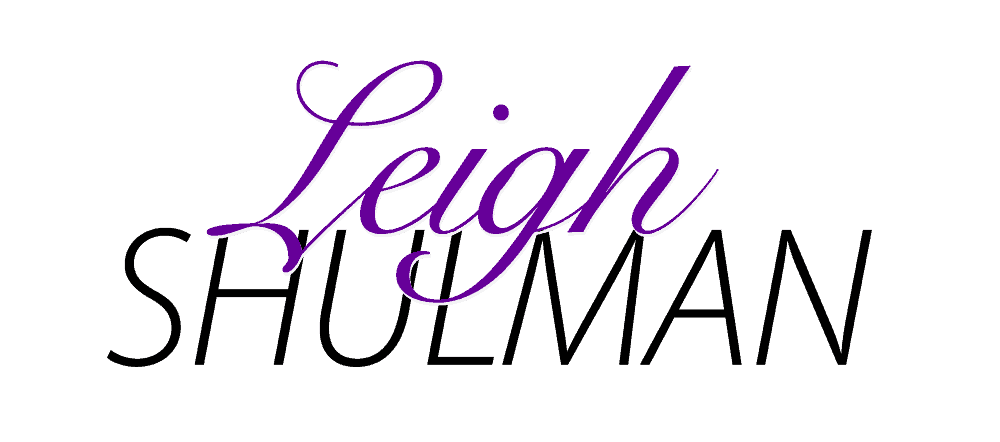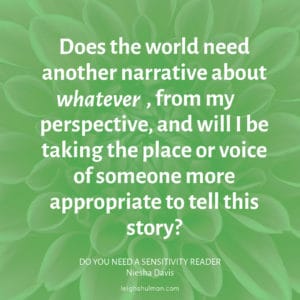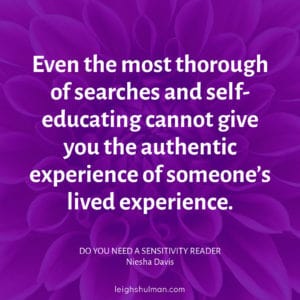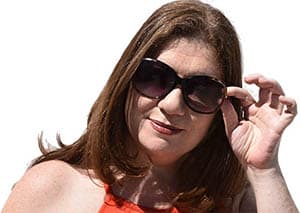Are you trying to make your writing more diverse and free of stereotypes and unconscious bias? You’ve done the research, you’ve read the articles on how to write more well-rounded characters, but something is still missing.
If this is the case, consider hiring a sensitivity reader work with you on your essay or manuscript. A sensitivity reader, also known as a diversity or authenticity reader, is a person who reads or looks at manuscripts, essays, and sometimes visual works of artwork, for issues with unconscious bias, stereotypes, and misrepresentation of a culture or group of people.
These types of beta-readers for authenticity are not new. Prior to it’s 2017 publication, Keira Drake’s YA novel The Continent, was criticized for it’s white savior narrative, including a plotline that found a teenager caught between “native” tribes. As a result, her publisher delayed release, sending the manuscript to two sensitivity readers, before ordering Drake to go back to the editing room.
In 2016 sex educator Annie Sprinkle was hired to work as a consultant on the Showtime tv series, The Deuce, a show about the golden age of adult film and sex work in 1970’s New York City. POSE, the FX series about the early days of ballroom and drag, consulted with drag legends Jose Xtravaganza and Leiomy Maldonado, for added realness.
The work however has been picking up steam in recent years, particularly around the time of the George Floyd murder and subsequent protests in early 2020. Since then, it seems many parts of American culture have been dealing with a reckoning, addressing all areas of our culture from the issues of police brutality to the #metoo movement, and the publishing industry. Hashtag movements like #ownvoices, a call-to-action to promote books featuring diverse characters have helped in the promotion of sensitivity readers too.
I’ve been working as a sensitivity reader for three years. It started innocently enough. One insomnia-induced night when I was living in Thailand, I found myself scouring media job boards in search of freelance work when I came across a writer looking for someone who has experienced sexual assault to review an as-told-by piece they were writing.
She needed someone to make sure that they hadn’t accidentally written anything that might read as obviously triggering or offensive to survivors. I got the gig, and from there with a testimonial in hand, I got another job, and continue to get a variety of clients on a regular basis. Independent authors, big publishing houses, film companies, schools, and PR & marketing firms are some demographics that hire diversity readers.
While the people who hire me usually come in with the best of intentions, there have been many times when people have shown up to the process unprepared to receive the feedback they need to avoid stereotyping and other similar issues with their writing..
People hiring a sensitivity reader want their manuscript to be as unproblematic as possible, especially in today’s quick-to-cancel culture but it can be hard to face the fact that you might not be as progressive or forward-thinking as you thought you were. If you’re not ready to face these issues within yourself, you may find yourself getting angry and defensive. I’ve even had people accuse me of “having it out for them,” when really I’m offering insight that’s in their best interests.
If you are planning on hiring a sensitivity reader, here are a few things to keep in mind as you prepare to work with one.
When should You engage an authenticity reader?
Before hiring a sensitivity reader, first ask yourself, “Should I even be writing this?”
Is this my story to tell? Does the world need another narrative about whatever, from my perspective, and will I be taking the place or voice of someone more appropriate to tell this story?
There are legitimate instances where you as a writer will want to write characters who are different from you. After all, erasing all characters who aren’t exactly like you from your work would create strange, monolithic, and ultimately unbelievable worlds.
When you write outside of your viewpoint and life experience, consulting with an authenticity reader is an excellent way to free your writing of stereotypes and unconscious bias. This includes writing characters that are of a different race, sexuality, religion, or gender from your own lived experience. Writers aren’t the only profession that benefits from SR. It extends to illustrators, filmmakers, educators, and animators creating work about or for marginalized communities.
When embarking on the process of writing outside of your viewpoint, research the people or the community you are representing. Research can mean reading up on common stereotypes and tropes associated with that group of people and writing to avoid the pitfalls. If writing diverse characters or a character opposite of you in some way is your goal, study the artwork, read the literature, follow activists and artists of that group and read their work and opinions.
Remember, even the most thorough of searches and self-educating cannot give you the authentic experience of someone’s lived experience as part of that group.
A sensitivity reader is not a stamp of approval
The first negative review I received from a sensitivity reader client came from someone who was upset that I wasn’t “more neutral,” in my approach to critiquing their work. The manuscript in question was tone-deaf and had many racist and sexist instances, which I pointed out and explained. Remember, this is what they hired me to do.
This instance, along with a few others, showed me that some people think sensitivity reading is just a stamp of approval. It is not., which it is not. Not everyone is going to be open to the kind of feedback a sensitivity reader is supposed to give.
This gig was a turning point, not only because it represented a time where a client was unsatisfied, but it also showed me that not everyone is going to be open to my feedback, even if that’s what they sought out and signed up for.
When you hire a sensitivity reader, you’re going to them so they can uncover your blind spots and educate you about your unconscious bias. It makes sense you might not know how to react to the revelation that you might not be as conscious, open-minded, or knowledgeable as you thought.
When working with a sensitivity reader, remember, their job is not to be neutral or mindful of your feelings. If you’ve written something tone-deaf, the consultant you hire needs to let you know this is the case. If your words come across as sexist or racist, be prepared to hear those exact words, and then be prepared to handle your feelings about hearing those words applied to your work.
A sensitivity reader is there to point out the problematic spots of your work. It may not always be easy to hear, but their observations are there to help you. They’re not there to help you process your ways of seeing the world. That’s the kind of work you have to do on your own.
Here’s an example of what to do if your sensitivity highlights something in your work that smacks of racism. You can apply the steps in that article if you feel called out by your sensitivity reader’s observations.
Most of all, don’t take their feedback personally. Instead, recognize they’re helping you create a better piece of writing.
Where To Find a Sensitivity Reader?
If you’re in the market for a sensitivity reader, there are a few excellent resources to start your search.
Sensitivity Reader Databases
Binders Full of Sensitivity Readers, a Facebook group created for sensitivity readers to discuss issues related to their work, has a database of readers for your work. Fill out this form to submit your inquiry to their group members.
Writing Diversely, is another website with a database of authenticity readers.
And of course, there’s always me.
How to search keywords and hashtags to find a sensitivity reader
Another way to find the type of diversity reader you’re looking for is to search keywords or hashtags of the type of professional you are seeking. Think phrases like: #jewishsensitivityreader, #diversityreader #diversityconsultant
This technique works on social media platforms like Twitter, Facebook, and Linkedn, as well as Google. Once you’ve found a sensitivity reader you’d like to work with, reach out to them to see if they are taking on new clients or not.
Each reader will list their areas of expertise, and if they don’t explain on their website, you can ask how they work and what they’ll specifically do when they read your work.
What to expect when hiring a diversity consult
When hiring someone to do a diversity edit on your work, you can expect them to read or review the material in full and provide a detailed summary of their findings and suggestions.
Sensitivity readers will generally look for bias and stereotypes as they relate to dialogue, character development, descriptors, mannerisms, plot points, and language. Much like regular editing, you can expect your authenticity reader to give you notes in track changes, pointing out issues and problems as they go along.
When I’m reviewing something, not only am I calling issues out, I make sure to explain what the issue is and why it’s a problem, while also including relevant resources for further research.
If you describe a Black character as having, “milk chocolate skin,” your diversity editor might point out how cliche and offensive it is to refer to people of color as food and give links to scholarly papers, videos, or articles on why that’s a no-no in writing diversely.
Other recurring issues include the use of problematic language, from calling people of color “magical” or “exotic,” or describing someone’s eyes as “almond-shaped,” to plain old stereotypes and tropes.
Once done critiquing the work in its entirety, I write out a longer summary and discuss overarching issues. Turnover times can vary from a few days, for shorter pieces like essays, to 2 or 3 weeks for book-length works. I also make myself available (upon request) for a half an hour follow-up to discuss my edits with the client, if they desire.
Every reader will work a bit differently, so make sure to ask your potential sensitivity reader how they’ll communicate their edits to you.
Sensitivity reading is part of your editing plan
Critics of sensitivity reading often cry about censorship. They say they worry that the employment of such professionals will over-sanitize art, thereby putting its authenticity in jeopardy. While a valid concern, I’m not overly convinced. In fact, when used correctly, sensitivity reading is a good tool to ensure authenticity.
It’s up to you as the author to incorporate feedback from your reader in a way that supports your narrative.
There is no foolproof way to make sure you don’t offend every single person or demographic. Yes, at times, you may still unintentionally put your literary foot in your mouth.
Hiring a sensitivity reader can’t give your writing a stamp of approval. Rather it’s one component of a plan – including research — to make your writing or work of art as realistic and unproblematic as possible while also telling the story you want to tell.



